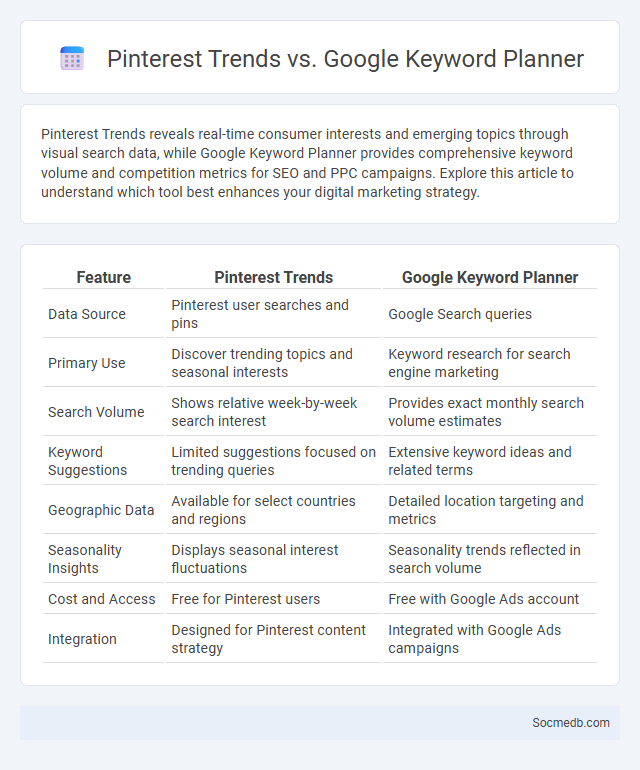
Photo illustration: Pinterest Trends vs Google Keyword Planner
Pinterest Trends reveals real-time consumer interests and emerging topics through visual search data, while Google Keyword Planner provides comprehensive keyword volume and competition metrics for SEO and PPC campaigns. Explore this article to understand which tool best enhances your digital marketing strategy.
Table of Comparison
| Feature | Pinterest Trends | Google Keyword Planner |
|---|---|---|
| Data Source | Pinterest user searches and pins | Google Search queries |
| Primary Use | Discover trending topics and seasonal interests | Keyword research for search engine marketing |
| Search Volume | Shows relative week-by-week search interest | Provides exact monthly search volume estimates |
| Keyword Suggestions | Limited suggestions focused on trending queries | Extensive keyword ideas and related terms |
| Geographic Data | Available for select countries and regions | Detailed location targeting and metrics |
| Seasonality Insights | Displays seasonal interest fluctuations | Seasonality trends reflected in search volume |
| Cost and Access | Free for Pinterest users | Free with Google Ads account |
| Integration | Designed for Pinterest content strategy | Integrated with Google Ads campaigns |
Introduction to Trend Analysis Tools
Trend analysis tools for social media leverage algorithms to track and predict emerging topics by analyzing vast amounts of user-generated data across platforms like Twitter, Instagram, and Facebook. These tools identify patterns in hashtags, keywords, and engagement metrics to help marketers, brands, and analysts make data-driven decisions for content strategy and audience targeting. Real-time monitoring and historical data comparisons enable businesses to anticipate shifts in consumer interests and capitalize on viral trends effectively.
Overview of Pinterest Trends
Pinterest trends highlight evolving user interests by analyzing billions of monthly searches, ranging from home decor to fashion and wellness. Data reveals seasonal spikes in categories like holiday recipes and outdoor activities, guiding brands in targeted content creation. Understanding Pinterest's visual discovery platform enables marketers to anticipate consumer behavior and optimize engagement strategies effectively.
Understanding Google Keyword Planner
Google Keyword Planner provides detailed insights into search volumes, keyword competition, and cost-per-click data, essential for optimizing social media campaigns. Marketers use this tool to identify high-performing keywords that enhance content visibility and engagement across platforms like Facebook, Instagram, and LinkedIn. Leveraging Google Keyword Planner helps target audience preferences more precisely, driving increased traffic and improving social media ROI.
Exploring Google Trends
Exploring Google Trends allows you to analyze real-time data on social media topics, helping identify rising hashtags and viral content in your niche. This powerful tool tracks search interest and regional popularity, enabling precise targeting for marketing campaigns on platforms like Instagram, Twitter, and Facebook. Leveraging Google Trends can enhance your social media strategy by providing insights into user behavior and trending conversations.
Data Sources and User Demographics Comparison
Social media platforms aggregate diverse data sources including user-generated content, behavioral analytics, and third-party data to build comprehensive profiles. Understanding user demographics such as age, location, gender, and interests enables targeted marketing and personalized content delivery. Your engagement with these platforms can be optimized by analyzing demographic trends and data source reliability to enhance outreach strategies.
Key Features and Functionality Breakdown
Social media platforms offer key features such as user profiles, content sharing, real-time messaging, and interactive elements like likes, comments, and shares that facilitate engagement and community building. Advanced algorithms curate personalized content feeds based on user behavior, preferences, and social connections to enhance user experience. Integration with multimedia tools, live streaming, and analytics dashboards enables businesses and influencers to track performance and optimize their digital presence effectively.
Trend Discovery and Insights Accuracy
Trend discovery on social media leverages advanced algorithms and real-time data analysis to identify emerging topics and viral content faster than traditional methods. Insights accuracy is enhanced through machine learning models that analyze user engagement patterns, sentiment, and demographic information, ensuring brands can tailor strategies with precision. These data-driven approaches enable marketers to predict audience behavior and capitalize on shifts in consumer interests effectively.
Use Cases for Content and Marketing Strategies
Social media platforms drive targeted audience engagement through tailored content marketing strategies such as influencer collaborations, user-generated content, and real-time customer interaction. Brands leverage analytics tools to optimize campaign performance by tracking metrics like engagement rate, click-through rate, and conversion rate. Effective use cases include product launches, brand storytelling, and personalized advertisements that increase ROI and enhance customer loyalty.
Pros and Cons of Each Tool
Social media platforms like Facebook offer robust community-building features but raise privacy concerns due to extensive data sharing. Instagram excels in visual content marketing and influencer engagement, though its algorithm-driven feed can limit organic reach. Twitter provides real-time news updates and networking opportunities, while its character limit sometimes hampers nuanced communication; understanding these trade-offs helps you optimize your digital strategy effectively.
Choosing the Right Tool for Your Needs
Selecting the appropriate social media platform depends on your target audience, content type, and marketing goals. Platforms like Instagram excel in visual storytelling, while LinkedIn is ideal for B2B networking and professional content. Understanding user demographics and engagement metrics ensures alignment with your brand strategy and maximizes ROI.
 socmedb.com
socmedb.com